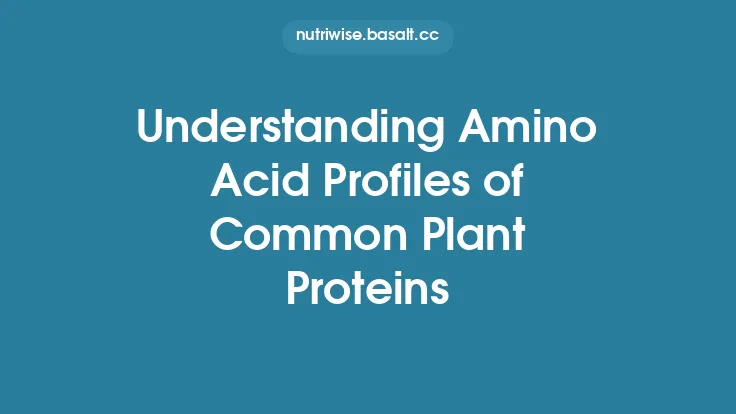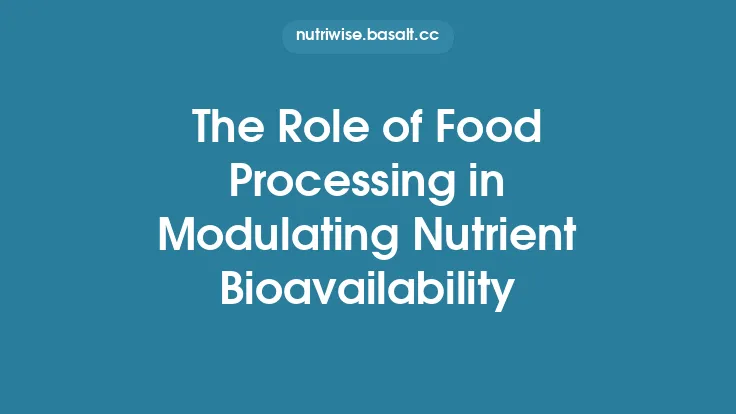Plant‑based proteins have become a cornerstone of modern diets, driven by health, environmental, and ethical considerations. Yet, the nutritional value of these proteins hinges not just on their amino acid composition but on how efficiently the body can digest, absorb, and utilize them—a concept known as bioavailability. Understanding the myriad factors that influence plant‑protein bioavailability is essential for nutrition professionals, food scientists, and anyone seeking to optimize the nutritional quality of vegetarian and vegan meals.
The Digestive Journey of Plant Proteins
Before delving into the variables that modulate bioavailability, it helps to outline the basic pathway a protein follows from ingestion to absorption:
- Mouth – Mechanical breakdown and limited enzymatic activity (salivary amylase) begin the process, though proteins are largely untouched at this stage.
- Stomach – Gastric acid denatures protein structures, exposing peptide bonds. Pepsin initiates proteolysis, generating smaller polypeptides.
- Small Intestine – Pancreatic proteases (trypsin, chymotrypsin, elastase) further cleave polypeptides into oligo‑ and di‑peptides and free amino acids. Brush‑border peptidases complete the hydrolysis.
- Enterocytes – Amino acids and small peptides are transported across the intestinal epithelium via specific carriers (e.g., Na⁺‑dependent neutral amino acid transporters, peptide transporter 1, PepT1).
- Portal Circulation – Absorbed amino acids enter the bloodstream, where they are distributed to tissues for protein synthesis, energy production, or other metabolic fates.
Any factor that impedes one of these steps can reduce the overall bioavailability of the protein source.
1. Amino Acid Profile and Limiting Essential Amino Acids
Plant proteins often differ from animal proteins in their essential amino acid (EAA) composition. While the total protein content may be high, the presence of one or more limiting EAAs can constrain the net utilization of the protein.
- Lysine is typically low in cereals (e.g., wheat, rice) but abundant in legumes.
- Methionine and cysteine are often limiting in legumes but are richer in nuts and seeds.
- Tryptophan can be scarce in many plant sources.
When a single EAA is present in insufficient quantities relative to human requirements, it becomes the bottleneck for protein synthesis, regardless of the overall protein intake. Combining complementary plant foods (e.g., rice + beans) can create a more balanced amino acid profile, a strategy known as protein complementation.
2. Protein Structure and Anti‑Nutritional Factors
a. Protein Denaturation and Aggregation
The native three‑dimensional conformation of plant proteins can affect enzyme accessibility. Highly ordered structures (e.g., globulins in soy) may resist proteolysis unless denatured. Thermal processing, high‑pressure treatment, or alkaline extraction can unfold these proteins, enhancing digestibility. However, excessive heat can also cause Maillard reactions, where reducing sugars react with lysine residues, rendering them unavailable for absorption.
b. Phytates, Tannins, and Polyphenols
Although the prompt restricts discussion of phytates in the context of mineral bioavailability, it is still relevant to note that phytates and tannins can bind proteins and impede protease activity. These compounds form complexes that shield peptide bonds from enzymatic attack, reducing the rate and extent of hydrolysis. Processing methods that reduce these anti‑nutrients (e.g., soaking, germination, fermentation) can improve protein digestibility without venturing into the mineral‑absorption domain.
c. Fiber Interference
Dietary fiber, especially insoluble fractions, can physically entrap protein particles, limiting their exposure to digestive enzymes. Moreover, certain soluble fibers increase the viscosity of intestinal contents, slowing the diffusion of enzymes and substrates. While fiber offers many health benefits, its impact on protein bioavailability must be considered when formulating high‑protein plant meals.
3. Processing Techniques and Their Impact
The way plant proteins are harvested, stored, and prepared exerts a profound influence on their bioavailability.
| Processing Method | Effect on Protein Structure | Net Impact on Bioavailability |
|---|---|---|
| Cooking (boiling, steaming) | Denatures proteins, reduces anti‑nutrients | Generally improves digestibility |
| Roasting / Dry‑heating | Enhances Maillard reactions at high temperatures | May reduce lysine availability |
| Fermentation (e.g., tempeh, miso) | Proteolysis by microbial enzymes, reduces phytates | Significantly boosts digestibility |
| Sprouting / Germination | Activates endogenous amylases & proteases, lowers anti‑nutrients | Improves amino acid availability |
| Extrusion (high‑pressure, high‑temp) | Alters protein matrix, can create new peptide bonds | Variable; often improves digestibility but may cause Maillard loss |
| Cold‑pressing (e.g., nut milks) | Minimal heat; retains native structure | May leave anti‑nutrients intact, limiting digestibility |
Choosing the appropriate processing method depends on the target food product, desired sensory attributes, and nutritional goals.
4. Enzymatic Activity Within the Food Matrix
Some plant foods contain intrinsic proteases that become active during storage or processing. For example, the enzyme leguminase in legumes can partially hydrolyze storage proteins during germination, creating smaller peptides that are more readily absorbed. Conversely, endogenous protease inhibitors (e.g., trypsin inhibitors in soy) can blunt the activity of digestive enzymes, reducing protein breakdown. Heat treatment typically inactivates these inhibitors, thereby enhancing protein bioavailability.
5. Interaction with the Gut Microbiome (Focused on Protein Metabolism)
While the broader topic of gut health is excluded, it is still pertinent to acknowledge that the colonic microbiota can ferment undigested protein residues, producing short‑chain fatty acids (SCFAs) and other metabolites. The extent of protein reaching the colon depends on upstream digestibility; thus, improving bioavailability reduces the substrate available for microbial proteolysis, potentially mitigating the production of harmful metabolites such as ammonia or phenols.
6. Food Matrix Effects Specific to Plant Proteins
The food matrix—the physical and chemical environment surrounding nutrients—modulates protein accessibility.
- Emulsified Systems (e.g., soy milk) disperse protein particles, increasing surface area for enzymatic attack.
- Gelatinized Starches (as in cooked grains) can encapsulate protein, limiting enzyme contact.
- Protein‑Rich Fractions (isolates, concentrates) remove much of the surrounding matrix, leading to higher digestibility but also higher susceptibility to heat‑induced damage.
Understanding these matrix interactions helps food technologists design products that balance texture, flavor, and nutritional quality.
7. Influence of pH and Ionic Strength
Digestive enzymes have optimal pH ranges (e.g., pepsin at pH 1.5–2.5, trypsin at pH 7–8). Plant foods that alter gastric pH—through high acidity (e.g., citrus‑based sauces) or alkalinity (e.g., certain legumes after soaking)—can affect enzyme efficiency. Additionally, the ionic strength of the intestinal lumen, shaped by the presence of salts and electrolytes, can modify protein solubility and enzyme–substrate interactions, subtly influencing absorption rates.
8. Age‑Related Variations in Protein Utilization
Although not a processing factor, physiological stage matters. Infants, children, adolescents, and older adults have differing protein requirements and digestive capacities. For instance, older adults often experience reduced gastric acid secretion, which can impair the initial denaturation of plant proteins, making them more dependent on pre‑treated or highly digestible protein sources.
9. Practical Recommendations for Maximizing Plant‑Protein Bioavailability
- Combine Complementary Sources – Pair cereals with legumes (e.g., rice and beans) to achieve a complete amino acid profile.
- Employ Beneficial Processing – Use soaking, sprouting, or fermentation to reduce anti‑nutrients and activate endogenous proteases.
- Apply Controlled Heat – Cook at moderate temperatures to denature proteins without excessive Maillard reactions.
- Select Protein‑Rich Fractions When Needed – For athletes or individuals with higher protein demands, consider isolates or concentrates, but balance with whole‑food intake for fiber and micronutrients.
- Mind the Food Matrix – Incorporate emulsified or finely milled forms to increase surface area, but be aware of potential texture changes.
- Monitor pH‑Modifying Ingredients – Use acidic marinades or alkaline soaking solutions judiciously to support optimal enzyme activity.
- Consider Age‑Specific Strategies – Older adults may benefit from pre‑digested protein products (e.g., hydrolysates) that bypass the need for extensive gastric digestion.
10. Emerging Research Directions
The field continues to evolve, with several promising avenues:
- Proteomics of Plant Foods – High‑throughput analysis of protein isoforms and post‑translational modifications to predict digestibility.
- Enzyme Engineering – Development of novel food‑grade proteases that can be added during processing to pre‑hydrolyze proteins.
- Precision Fermentation – Using tailored microbial consortia to produce plant‑based protein ingredients with optimized amino acid profiles.
- In‑Vitro Digestion Models – Simulated gastrointestinal systems that better mimic human digestion, allowing rapid screening of processing methods.
- Personalized Nutrition Platforms – Integrating genetic data (e.g., variations in amino acid transporters) to tailor plant‑protein recommendations.
Concluding Perspective
The bioavailability of plant‑based proteins is a multifactorial phenomenon shaped by intrinsic protein characteristics, anti‑nutritional components, processing techniques, and the surrounding food matrix. By systematically addressing each of these variables—through thoughtful food design, appropriate culinary practices, and ongoing scientific innovation—nutrition professionals can ensure that plant proteins deliver their full nutritional potential, supporting health across the lifespan.





